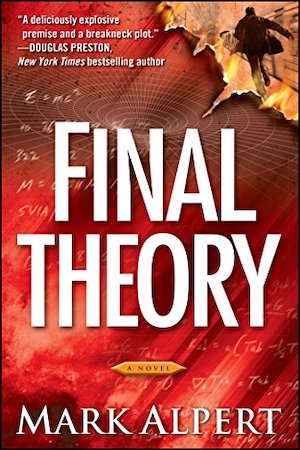
Summary:
David Swift, a failed physicist turned science historian, is summoned by the police to the deathbed of his former mentor, renowned physicist Hans Kleinman. The elderly scientist and student of Albert Einstein was beaten and tortured by an unknown assailant seeking information about the Einheitliche Feldtheorie, or unified theory, a single set of equations that would explain all the forces of Nature. Einstein spent the second half of his life searching for this theory, but he died without discovering it. Or did he?
Within hours of hearing his mentor’s last words—and a mysterious sequence of seemingly random digits–David is running for his life. The FBI and a ruthless Russian mercenary are vying to get their hands on the long-hidden theory. Teaming up with an old girlfriend, brilliant Princeton physicist Monique Reynolds, David embarks on a frenzied cross-country quest, frantically trying to piece together Einstein’s Final Theory to reveal its staggering consequences.
Publication Date: 2008
Category: science thriller novel
ScienceThrillers technical content rating: ![]()
ScienceThrillers.com book review of Final Theory :
This may be the only thing you need to know about Final Theory to decide whether you want to read it or not: it’s a science thriller about theoretical physics, and there aren’t many of those. So if you’re sick of plagues, bioterrorism, corrupt pharmaceutical companies, and heroic pathologists, Mark Alpert’s novel with its climax set at Fermilab may be just what you’re looking for. The author is a science journalist and editor for Scientific American; he knows his stuff. The technical content of Final Theory is convincing, clear (for theoretical physics), and well-utilized.
Alpert’s debut novel has an original and entertaining premise. The plot fits genre expectations: it’s fast-moving and action-packed but formulaic (ordinary guy ripped from his ordinary life, unjustly accused, goes on the run, must complete a quest while staying one step ahead of both the law and the villain), with some rather ridiculous plot twists and impossible injury recovery. Probably the novel’s biggest weakness is characterization of the villains. Without giving away any spoilers, I’ll summarize and say that Alpert relies on trite, cardboard characters. To create “complexity”, he juxtaposes good and bad traits that don’t add depth; rather, the reader can’t believe that such opposites could exist in a single real person. Political figures in the book are undisguised clones of the Bush-Cheney-Rumsfeld White House of the day, and they are portrayed as the worst caricatures a left-leaning author could imagine. A variety of people are stereotyped in unflattering ways, including rural dwellers, religious fundamentalists, lawyers, Texans, and soldiers.
But we come back to, a physics-based science thriller. I’ll forgive a lot for that.
Parent alert: foul language, including the f-word; mildly graphic torture; prostitution
If you’re more a math/physics type, read: The Fractal Murders by Mark Cohen
Alpert’s books featuring David Swift and physicist Monique Reynolds:
Final Theory (2008); The Omega Theory (2011)
If you like this book, you might also like:
No Results Found
The page you requested could not be found. Try refining your search, or use the navigation above to locate the post.

0 Comments